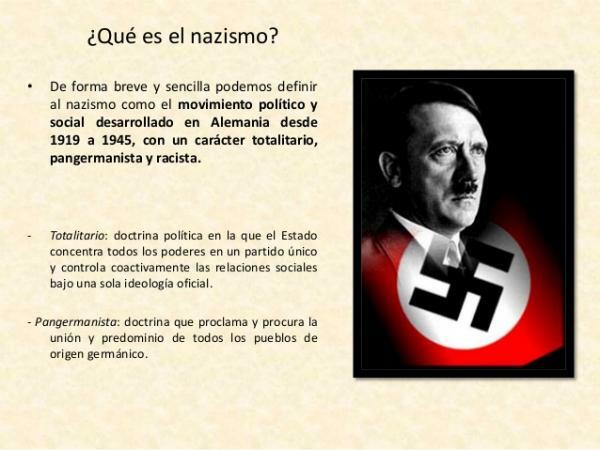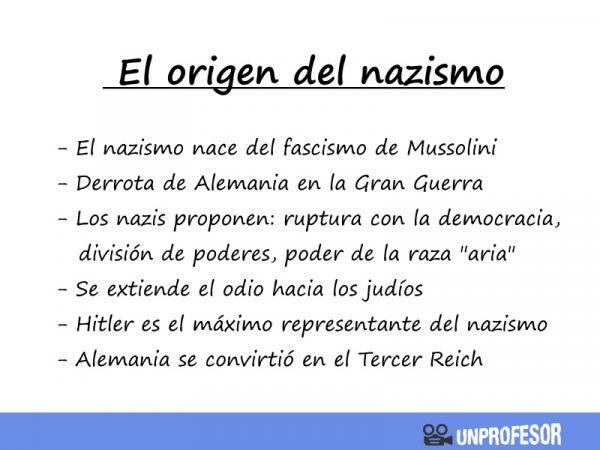9 characteristics of the NAZI ideology

Nazism is one of the political ideologies that has brought more deaths in the history of mankind, being the cause of the greatest war in history, and whose thought not only brought war deaths, but its repression also brought a large number of murders to the town. To talk about this movement that brought so much pain to humanity in this lesson from a PROFESSOR we are going to offer a summary of Nazi ideology and characteristics.
The Nazismis the ideology of the National Socialist German Workers' Party, being the party that led by Adolf hitler ruled Germany from 1933 to 1945. This ideology was the characteristic of the so-called Third Reich, being a dictatorship characterized by authoritarian, racist and violent thinking.
Nazi influence spread over the years by the nations that the Germans had conquered during the Second World War, although in none of these did it have the relevance that it did in Germany. These states were Austria, France, Czechoslovakia, Hungary, the Netherlands, Denmark, and Norway.

Image: Slideshare
We are going to offer a brief summary of Nazism so that you better understand how it arose and how it evolved. The origin of nazism we can find it in the 20's, being a period in which Germany was in a harsh economic and social situation caused in large part by the defeat it had suffered during the First World War. In this crisis situation, it was increasingly common to see the emergence of radical and violent groups, both on the left and on the right.
The triumph of some dictatorships in the world, the greatest example being that of the regime established in Italy by Mussoliniand the crises of liberal democracies that had fallen into a strong economic depression, brought the idea to Germany that the best way out of the crisis and back to being a strong Germany was through a dictatorship.
In this situation, a young Hitler ascended quickly by the German Workers' Party, taking a short time to reach the head of the party and be called Führer. Little by little the new leader of the party was establishing the ideas of Nazism, such as hatred of Jews or the search for German dominance in Europe.
Seeing the increasingly decaying situation in Germany, Hitler attempted a coup called the Munich Putsch, which was a failure and brought the incarceration Hitler. The German leader only spent 11 months in jail, but they served to finish his thoughts on the Nazi ideology and to get great support from the German citizenry.
It was in 1933 that Hitler came to power as Chancellor of Germany, starting from that moment the conversion of Germany into a dictatorship where the Nazi ideology predominated. Little by little, he changed the nation's structures, created paramilitary groups to create repression against those opposed to his ideas and assassinated all those leaders who will confront him.
After he came to power, started the Second World War for Germany to be the sovereign nation of Europe and spread Nazism through the conquered regions. It was not until its defeat in war and death that Nazism was tried and disappeared.

To conclude this lesson we must talk about the main characteristics of Nazism, to understand their thinking. The main characteristics of Nazism were the following:
- Authoritarianism: Nazism was based on a dictatorial authoritarian state, loyalty had to be total with the Führer, who controlled all the institutions of the nation and the citizens. Government bodies were created in different areas to govern all possible areas.
- Antiparliamentarism: Rejects democracy, since absolute power must belong to the Führer and society cannot decide on it. The only valid party should be Hitler's party, which governed all regions for life.
- Freedoms: Freedoms were minimal, and they were only possible for those considered to be German citizens. People not considered to be German citizens could suffer all kinds of limitations on freedom and violence.
- Violence: The German government used violence and force to achieve its ends, both militarily and through the repression of the people. Paramilitary organizations such as the Gestapo or the H.Hfor the acts that they carried out and that were condemned years later.
- Racism: Nazism considered the Aryan race as the superior race, all the others being one step below and therefore being less important human beings. Even so, Hitler sometimes gave the honorary title of Aryan to people who did not fall within the scope of what was understood as Aryan but whom the Führer respected.
- Anti-communist and anti-liberal: He faced both liberalism and communism, seeking a third way.
- Propaganda: The propaganda and control of the media was aimed at controlling the thinking of those opposed to Nazism and extolling the figure of Hitler.
- Foreign policy: Foreign policy was militaristic and expansionist, seeking the growth of Nazi thought throughout Europe.
- Antisemitism: The main Nazi racism was towards the Jews, being the most punished during the war and especially through the concentration camps where thousands of murders were carried out against Jews.


